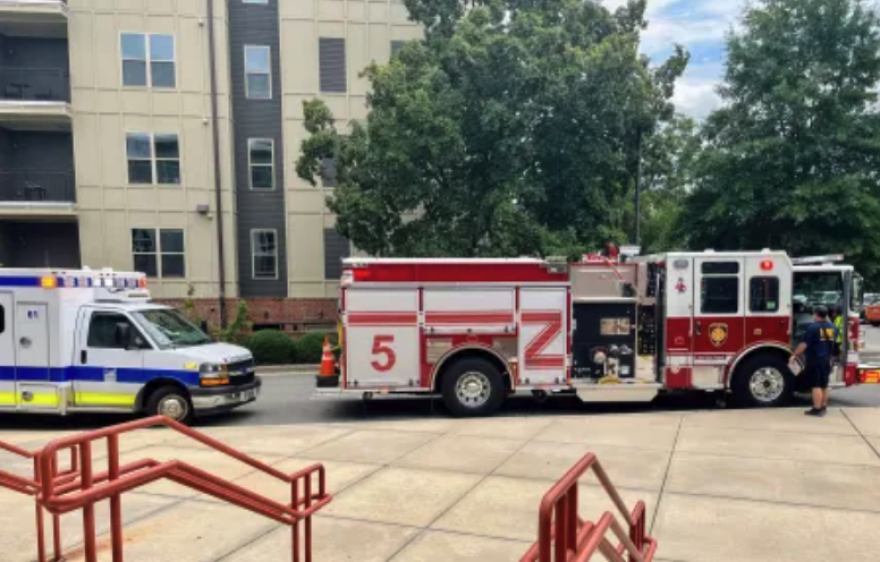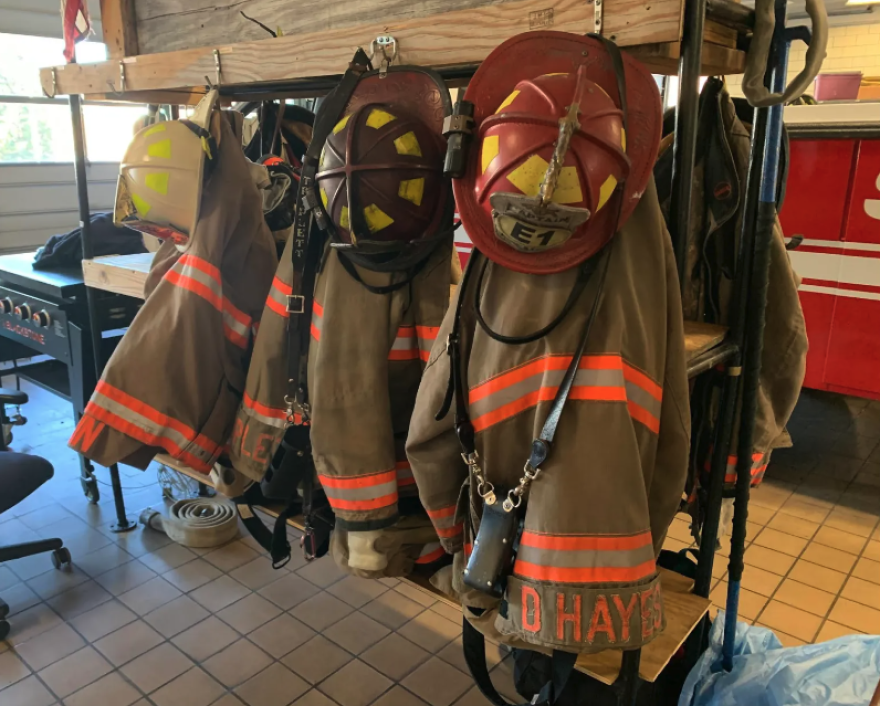Firefighter Jason Burns appreciates the attention that firefighting foam has received recently because long term exposure to it has been linked to cancer. However, he says he’s rarely used firefighting foam in his nearly 20-year career.
“I tend to focus on our gear because most fire departments aren’t using foam on a regular basis, whereas I’m using my gear, firefighters are using our gear 10-14 times a tour, which is what we call our day of work,” he said.
Burns’ “turnout gear” is the heavy, multilayered set of clothes that protects firefighters from heat, water and other liquids such as hot oils encountered while responding to an emergency. Several layers of the gear — usually the outermost layer and an inner moisture barrier — are coated with PFAS, which efficiently repels liquids while allowing for breathability. Oil and water repellency and heat resistance are key safety features of turnout gear.
But in recent years, use of PFAS in turnout gear has come under scrutiny. Accumulating science points to the cancer risks of being exposed to these so-called forever chemicals — per- and polyfluorinated substances — over time.
“Every firefighter knows there is a link between the job and occupational illnesses, including cancer. The studies prove it,” said Edward Kelly, president of the International Association of Firefighters.
It’s challenging to pinpoint what might be responsible for the . During the course of their work, firefighters are exposed to multiple carcinogens in the fumes of burning buildings and vehicles.
Many firefighters, like Massachusetts’ Burns, are increasingly pointing to their PFAS-laden gear as a source of their health woes. They spend long days exposed to their gear.
As firefighters push for removing PFAS from turnout gear, the question is what will replace it? In removing PFAS, could firefighters be swapping the long term risks of PFAS with shorter term risks of injury from less effective gear?
‘A trade-off we have to understand’
Bryan Ormond understands that the PFAS issue is an emotionally charged topic for many firefighters. Even so, the textiles expert from North Carolina State University told a gathering of scholars and advocates earlier this month that the industry should proceed with caution as they seek a replacement for the current turnout gear.
At the held at UNC Chapel Hill, Ormond argued that more research is needed to better understand the risk level presented by the various contamination pathways, such as skin and respiratory exposure.
“One of the things that you will hear when you hear about PFAS in firefighting … is that these chemicals are there for water repellency — that’s not entirely true,” he said. If the only thing the firefighting turnout gear needed to do was repel water, Ormond said, it would be easier to find a PFAS-free alternative.
However, he says, the PFAS-coated outer layer also repels slick liquids such as oils and fuels. The PFAS compounds in the moisture barrier allow moisture vapors to escape while also preventing moisture from collecting on the skin and potentially burning a firefighter who’s in an environment where temperatures can soar.
“Most of the responses that firefighters go to have nothing to do with fire,” he said. “They are mostly EMS calls and things like that … They also respond to car accidents, auto body shop fires, where they can see diesel fuel, gasoline, hydraulic fluid — these types of chemicals we still need to have protection from. And so it’s a trade-off that we have to understand.”
By repelling water and oil, PFAS compounds prevent the turnout gear from becoming saturated and heavy — and in the case of oil saturation, it minimizes the chance the gear will catch fire either at the time of the incident or at a subsequent fire event.
The IAFF says manufacturers are shifting the responsibility for inspecting the gear onto firefighters, when it should be handled by the manufacturer.
“We would support anything that would make firefighters safer,” said Tim Bradley, executive director of the . “But right now, we don’t know that there’s a definitive answer to what’s the replacement for the gear we have.”
Identifying exposure risks
Adding more complexity to the situation is the fact that fluorinated compounds are found in products used by the general public daily, such as electronics, nonstick cookware, makeup, upholstery, carpets, waxy food wrappers, workout clothing, rain coats and dental floss, among other things.
So, when a house or building catches fire, Ormond says smoke from the materials burning, which may contain PFAS and other toxic compounds, settles on the turnout gear and makes it difficult for researchers to determine, during tests, whether the particles are a result of the gear’s finish breaking down or are from airborne particle accumulation settling on the gear during a fire event.
Firefighters told Ormand that, “We've created a very efficient process of taking contamination from a scene and taking it back to the station.”
“It gets on the gear, they don’t really clean it all as well, in some places, and it goes back and you detect it in the dust in the firehouse. So just because it’s there, we don’t know how it got there. We don’t know if it’s from the fabric originally or from the fire scene.”
Another exposure risk for firefighters targets “incident commanders and people operating the engine and the pump,” who are not wearing respiratory protection, according to Ormond. That’s another route of exposure to probable carcinogens.
Researchers say firefighters who remain with the truck during a fire event should wear respirators to reduce exposure risk to chemical-laden smoke.

are chemicals found in coal, crude oil and gasoline. Firefighters can come into contact with PAHs during a fire event by way of the chemicals in the smoke and fumes. Long term exposure to PAHs could result in blood and liver problems and possibly cancer, according to the Centers for Disease Control and Prevention.
Ormond referenced a conducted by the University of Arizona Tucson that measured the levels of PAHs present in the blood of a pump operator, who remained outside. Those researchers found the pump operator’s PAHs levels were as high as those of the firefighters who entered the building because he was not wearing a respirator and was exposed to the smoke.
Lowering the burden of proof
The rate at which firefighters develop cancer outpaces the general population by 9 percent, and their risk of dying from cancer is 14 percent higher, according to a by the National Institute for Occupational Safety and Health.
In the past, federal firefighters had a difficult time getting cancer-related claims accepted for workers’ compensation, because the burden of proof was too high: Claims required firefighters to specify which carcinogen they were exposed to and when the exposure occurred.
That’s finally starting to change.
Kelly’s organization long pressed federal officials to allow federal firefighters to file for “presumptive benefits,” and this year, Congress responded. Lawmakers added a provision in the that now, the presumption will be that if a firefighter is diagnosed with certain cancers, the cause was occupational. This means firefighters will receive workers’ compensation benefits for cancer claims.
“For far too long our federal firefighters, and their families, have been left behind, and we are thankful to have finally been able to secure this well-deserved benefit,” Kelly said .
There is a provision in the NDAA that prohibits the Department of Defense from purchasing firefighting turnout gear that has been manufactured with per- and polyfluoroalkyl substances once a PFAS-free alternative has been developed.
Additionally, the DOD is charged with “releas[ing] information on the health effects of PFAS exposures for fire fighters, veterans and their families.”
What will replace PFAS?
can lead to increased risks for high cholesterol, compromised immune responses in adults and children, high blood pressure or pre-eclampsia in pregnant women and kidney and testicular cancer.
The preponderance of evidence and the history of cancer in the fire service has led firefighters and their supporters, including many researchers, to call for PFAS-free turnout gear, which they hope will reduce cancer exposure.
Kelly recently made it clear how the IAFF feels about this matter.
“The sooner we have PFAS-free gear, the safer we will be on the job and in our communities.”
There are firefighters who would like to reduce cancer-exposure risks, but who also agree with Ormand in thinking more research is needed.
“There’s PFAS in a lot of stuff … We can’t jump off the deep end and say ‘We’re going to get rid of turnout gear,’ because that’s how we do our job, right?” he said. “And [turnout gear] protects us in the greater sense from more harmful particulates, so right now we have to wait and see where all the research leads us to.”
Ormond says more research is needed to determine the following:
- The impact of fire-scene contaminants, including PFAS released from burning structures and consumer products, on firefighters’ skin and respiratory systems.
- Whether alternative moisture barrier gear will perform as well as the current gear without increasing heat stress on the firefighter.
- How firefighters with high PFAS levels in their blood respond to other ground exposures such as carcinogenic compounds.
He said that if firefighters focus on the fabric, but that turns out to be a “minor contributor, we haven't solved a lot, right?”
This first appeared on and is republished here under a Creative Commons license. North Carolina Health ����app is an independent, non-partisan, not-for-profit, statewide news organization dedicated to covering all things health care in North Carolina. Visit NCHN at .






